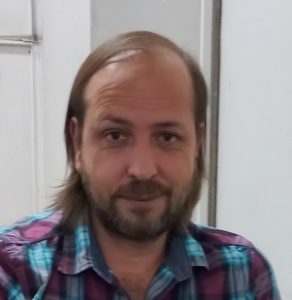- Antigen-presenting cells and inflammatory response
- Experimental immunology
- Experimental Oncology
- Experimental Thrombosis and Immunobiology of Inflammation
- Genetics of Lymphoid Malignancies
- Haemostasis and thrombosis
- Hematological genetics
- Immunology of Respiratory Diseases
- Innate immunity
- Molecular Genetics of Hemophilia
- Mutagenesis
- Onco-immunology
- Pathogenesis and inmunology of infectious processes
- Pathogenesis of viral infections
- Pharmacogenomics
- Physiology of Inflammatory processes

Mutagenesis
General Description of the lab
The focus of our laboratory is to comprehensively address the various metabolic processes that occur on DNA, which influence the generation and repair of genomic damage, in order to understand the genesis of mutations with the potential to generate therapy-related secondary tumors, as well as neurodegenerative diseases. Through this integration, we intend to identify new therapeutic targets that represent vulnerabilities for the development and progression of altered cells on which to design new targeted therapies.

Chair: Marcelo de Campos Nebel, PhD
Research Scientist from CONICET.
mnebel@hematologia.anm.edu.ar
 Co-Chair: Marcela Beatriz González Cid, PhD
Co-Chair: Marcela Beatriz González Cid, PhD
Research Scientist from CONICET.
margoncid@hematologia.anm.edu.ar
- Marcela González Cid, PhD. Research Scientist from CONICET.
- Marcelo de Campos Nebel, PhD. Research Scientist from CONICET.
- MSc. Néstor Aznar. PhD fellow from CONICET. Mentor: Dr. de Campos Nebel.
- MSc. Camila Gosso. PhD fellow from CONICET. Mentor: Dr. de Campos Nebel.
- Alan Maximiliano Segovia, MSc. student. Mentor: Dra. González Cid.
Research projects
The nature of the DNA double helix requires the constant removal of topological barriers to allow various metabolic processes to take place within the nucleus that are necessary for cellular life. Topoisomerases (Top) achieve this through the temporary interruption of genome integrity and subsequent restoration of the continuity of the DNA double helix. In this way, Topoisomerases form transient phosphodiester bonds with 3′ ends (Top1) or 5′ ends (Top2) of DNA. Several chemotherapeutic agents and certain genomic lesions increase the half-life of these DNA-bound enzymes and generate protein blocks at the DNA ends. These structures require specialized removal mechanisms to enable their repair. The progression of DNA replication forks as well as the passage of the transcriptional machinery can be disrupted by these protein blocks, leading to stalling or collapse of these structures. This can delay the mentioned processes or even result in harmful genomic lesions that require repair to prevent the generation of mutations. The removal of protein blocks from DNA ends requires both nucleolytic and hydrolytic activities. In the former case, nucleolytic cleavage of a DNA segment containing the blocking protein takes place, eventually resulting in the loss of genetic material. On the other hand, cellular hydrolases (TDP1 and TDP2) are capable of directly removing phosphodiester bonds between the blocking proteins and DNA. Alterations in these processes may be responsible for resistance to oncology therapies or even neurodegenerative conditions.
The current research projects being carried out in our laboratory can be summarized as follows:
- Identification of the molecular and cellular mechanisms responsible for the removal of cleavage complexes stabilized by Top2 poisons. (Aznar/de Campos Nebel)
- Evaluation of the effect of chromatin states on the repair activity of Tyrosyl-DNA phosphodiesterases in response to Top2 poisons. (Gosso/de Campos Nebel)
- Analysis of the interplay of DNA damage response (DDR) elements that maintain genome integrity against damage generated by Top2 poisons. (Segovia/González Cid).
- Alternative end-joining originates stable chromosome aberrations induced by etoposide during targeted inhibition of DNA-PKcs in ATM-deficient tumor cells. de Campos Nebel M, Palmitelli M, Pérez Maturo J, González-Cid M. Chromosome Res. 2022 Dec;30(4):459-476. doi: 10.1007/s10577-022-09700-w.
- Measurement of Drug-Stabilized Topoisomerase II Cleavage Complexes by Flow Cytometry. de Campos Nebel M, Palmitelli M, González-Cid M. Curr Protoc Cytom. 2017 Jul 5;81:7.48.1-7.48.8. doi: 10.1002/cpcy.21.
- A flow cytometry-based method for a high-throughput analysis of drug-stabilized topoisomerase II cleavage complexes in human cells. de Campos-Nebel M, Palmitelli M, González-Cid M. Cytometry A. 2016 Sep;89(9):852-60. doi: 10.1002/cyto.a.22919.
- Tyrosyl-DNA-phosphodiesterase I (TDP1) participates in the removal and repair of stabilized-Top2α cleavage complexes in human cells. Borda MA, Palmitelli M, Verón G, González-Cid M, de Campos Nebel M. Mutat Res. 2015 Nov;781:37-48. doi: 10.1016/j.mrfmmm.2015.09.003.
- Progression of chromosomal damage induced by etoposide in G2 phase in a DNA-PKcs-deficient context. Palmitelli M, de Campos-Nebel M, González-Cid M. Chromosome Res. 2015 Dec;23(4):719-32. doi: 10.1007/s10577-015-9478-4.
- DNA-PKcs-dependent NHEJ pathway supports the progression of topoisomerase II poison-induced chromosome aberrant cells. Elguero ME, de Campos-Nebel M, González-Cid M. Environ Mol Mutagen. 2012 Oct;53(8):608-18. doi: 10.1002/em.21729.
- Topoisomerase II-mediated DNA damage is differently repaired during the cell cycle by non-homologous end joining and homologous recombination. de Campos-Nebel M, Larripa I, González-Cid M. PLoS One. 2010 Sep 2;5(9):e12541. doi: 10.1371/journal.pone.0012541.